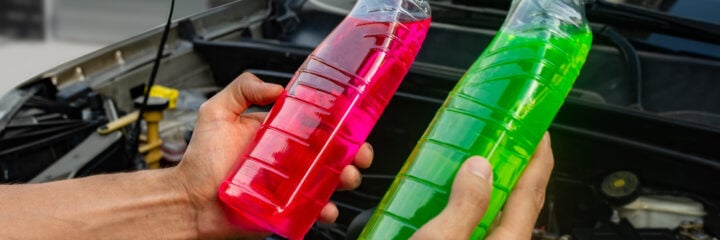Antifreeze, by definition, is an ethylene glycol-based additive liquid used to lower the freezing point of water. In automotive usage, it acts as a temperature regulator. It’s used in the radiator of a vehicle to reduce the water temperature when it’s boiling as well as to prevent water from freezing when the temperature outside falls drastically. This is why it’s popularly known as an engine coolant.
In addition to keeping the engine cool in summers and appropriately warm in winters, antifreeze also prevents engine components from corrosion and rusting.
What Are the Different Types of Antifreeze?
Antifreeze used by most well-known car companies belongs to one of the three following types based on their chemical composition:
1. Organic Additive Technology (OAT) Coolants
OATs Antifreeze liquids are usually made of carboxylates and triazole that are organic additives and come in predominantly purple, orange, yellow, or red colors. These coolants are known to extend the life of the engine due to their non-depleting corrosion inhibitors. OATs are also widely adopted by brands like General Motors. You can go up to 50,000 miles before changing this coolant.
2. Inorganic Additive Technology (IAT) Coolants
IATs, usually used in older car models, include chemical corrosion inhibitors like nitrates, borates, phosphates, silicates, etc. These are conventional coolants created using older and inferior formulas and require changing every year or two or after 24000 miles. They’re usually green in color.
3. Hybrid Organic Additive Technology (HOAT) Coolants
HOATs combine the formula for both IATs and OATs. They are ethylene glycol based coolants that comprise of both organic corrosion inhibitors as well as silicates, nitrites, etc., to protect metallic components like aluminum. HOAT antifreeze liquids are usually orange or yellow in color.
Can Red and Green Antifreeze Be Mixed?
The short answer is no. Red and green antifreeze cannot and should not be mixed they’re made using different formulas and may end up damaging your engine or leading to costly repairs.
Red and green antifreeze use different acid additives to prevent corrosion. Mixing these might result in adverse reactions like coagulation and the formation of a thick substance with a jelly-like consistency that will beat the purpose of using a coolant, or the liquid might turn acidic, leading to costly damages.
Always go with the coolant recommended by the manufacturer. Although different colored coolants aren’t a great indicator of different antifreeze formulas, most can be categorized as IATs, OATs, or HOATs. If you want a smooth functioning radiator with a perfect coolant, do not mix different colored OATs or HOATs either as the organic additive used in different colored coolants also varies, and mixing them might impair their proper functioning.
Instead of going by the color, read the list of contents included in the coolant’s formula and determine whether they’re the same. Even so, it’s best to go by the manufacturer’s recommendation or consult an authorized car service center.


